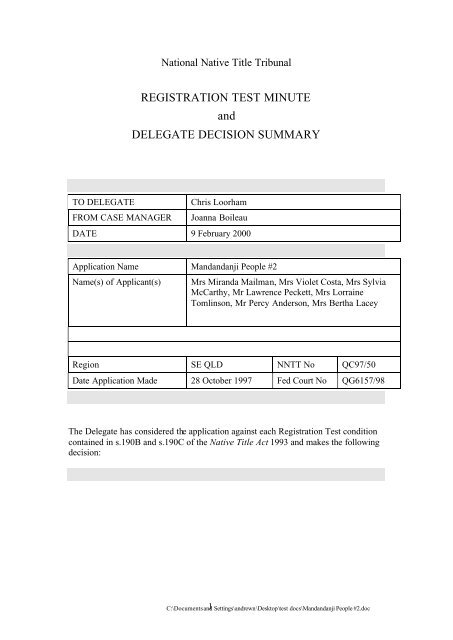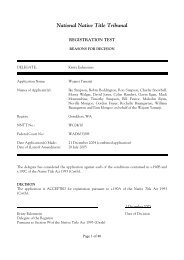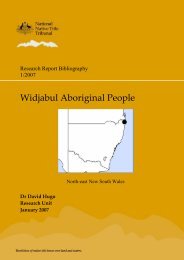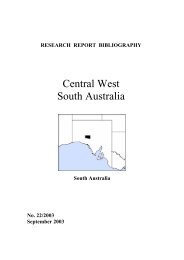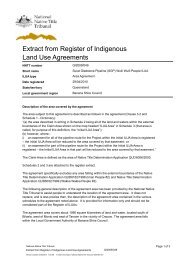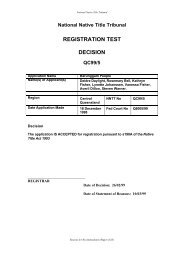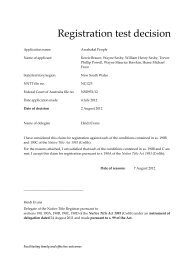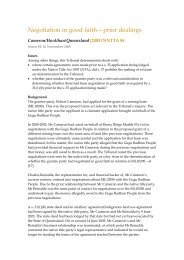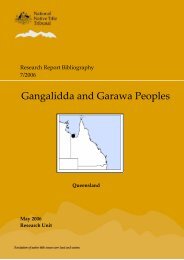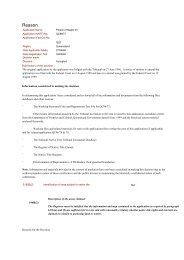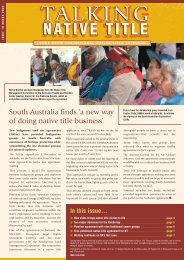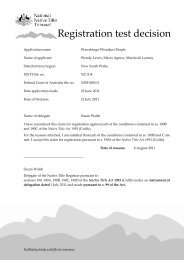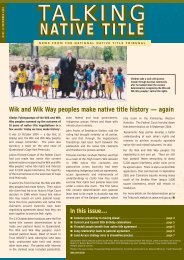Mandandanji People #2 - National Native Title Tribunal
Mandandanji People #2 - National Native Title Tribunal
Mandandanji People #2 - National Native Title Tribunal
Create successful ePaper yourself
Turn your PDF publications into a flip-book with our unique Google optimized e-Paper software.
<strong>National</strong> <strong>Native</strong> <strong>Title</strong> <strong>Tribunal</strong><br />
REGISTRATION TEST MINUTE<br />
and<br />
DELEGATE DECISION SUMMARY<br />
TO DELEGATE<br />
Chris Loorham<br />
FROM CASE MANAGER Joanna Boileau<br />
DATE 9 February 2000<br />
Application Name <strong>Mandandanji</strong> <strong>People</strong> <strong>#2</strong><br />
Name(s) of Applicant(s)<br />
Mrs Miranda Mailman, Mrs Violet Costa, Mrs Sylvia<br />
McCarthy, Mr Lawrence Peckett, Mrs Lorraine<br />
Tomlinson, Mr Percy Anderson, Mrs Bertha Lacey<br />
Region SE QLD NNTT No QC97/50<br />
Date Application Made 28 October 1997 Fed Court No QG6157/98<br />
The Delegate has considered the application against each Registration Test condition<br />
contained in s.190B and s.190C of the <strong>Native</strong> <strong>Title</strong> Act 1993 and makes the following<br />
decision:<br />
C:\Documents and 1 Settings\andrewn\Desktop\test docs\<strong>Mandandanji</strong> <strong>People</strong> <strong>#2</strong>.doc
Brief history of the application<br />
This application was the second lodged on behalf of the <strong>Mandandanji</strong> <strong>People</strong>, on 28<br />
October 1997. The first application of the <strong>Mandandanji</strong> <strong>People</strong> (QC97/30) was<br />
lodged on 12 September 1997 and withdrawn on 7 July 1998. The notification of<br />
interested persons and organisations has not yet commenced. An amended<br />
application was lodged in the Federal Court on 30 September 1999 and leave to<br />
amend was granted by the Court on 13 October 1999.<br />
In making this decision I have considered material provided directly to the <strong>Tribunal</strong><br />
for my consideration in the application of the registration test and in some instances<br />
relied on this material in making this decision. This material included: the affidavits<br />
of (name deleted) dated 8 November 1999, (name deleted) dated 25 June 1999 and<br />
(name deleted) dated 9 September 1999; a letter from (name deleted) dated 11<br />
November 1999 and a letter from the applicants legal representatives dated 30<br />
November 1999 in relation to this letter.<br />
After agreement was reached with the State of Queensland (‘State’) about the<br />
conditions of release of this material, copies of the documents were provided to the<br />
State. By letter of 10 February the State indicated to the <strong>Tribunal</strong> that it did not wish<br />
to respond to the material. (See State of Western Australia v <strong>Native</strong> <strong>Title</strong> Registrar &<br />
Ors [1999] FCA 1591 – 1594 regarding the <strong>Tribunal</strong>s responsibility to afford the State<br />
an opportunity to comment on material it considers).<br />
Documents considered<br />
Relevant documents held in:<br />
♦ Working File, QC97/50, Part 1<br />
♦ Personnel File, QC97/50<br />
♦ Registration Test Compliance File, QC97/50<br />
♦ Working File, QC 97/33<br />
♦ Other tenure information acquired by the <strong>Tribunal</strong> in relation to the area covered<br />
by this application<br />
♦ The <strong>National</strong> <strong>Native</strong> <strong>Title</strong> <strong>Tribunal</strong> Geospatial Database<br />
♦ The Register of <strong>Native</strong> <strong>Title</strong> Claims<br />
♦ The <strong>Native</strong> <strong>Title</strong> Register<br />
♦ The Register of Indigenous Land Use Agreements<br />
C:\Documents and 2 Settings\andrewn\Desktop\test docs\<strong>Mandandanji</strong> <strong>People</strong> <strong>#2</strong>.doc
Decision of Delegate<br />
For the reasons set out below the Application for <strong>Native</strong> <strong>Title</strong> Determination<br />
<strong>Mandandanji</strong> <strong>People</strong> <strong>#2</strong> IS ACCEPTED for registration pursuant to s.190A of the<br />
<strong>Native</strong> <strong>Title</strong> Act 1993<br />
DELEGATE<br />
DATE<br />
C:\Documents and 3 Settings\andrewn\Desktop\test docs\<strong>Mandandanji</strong> <strong>People</strong> <strong>#2</strong>.doc
A. Procedural Conditions<br />
190C2<br />
Information, etc, required by section 61 and section 62:<br />
The Registrar must be satisfied that the application contains all details and other<br />
information, and is accompanied by any affidavit or other document, required by<br />
sections 61 and 62.<br />
Reasons for Decision<br />
I have examined all the details and other information together with the affidavits and<br />
other documents accompanying this application. I find that s61 and s62 have been<br />
complied with. The application contains all the information etc required by s61 and<br />
s62 as I have outlined below.<br />
s.61(3); Names of applicant(s) and address for service is provided.<br />
s.61(4); Description of persons in native title claim group is provided.<br />
s.61(5); Application is in prescribed form, lodged in Federal Court, contains<br />
prescribed information and is accompanied by any prescribed documents 1<br />
s.62(1)(a) The application is accompanied by affidavits which comply<br />
s.62(1)(b); Details required in s.62(2) above are provided.<br />
s.62(1)(c); Details of physical connection are provided.<br />
Details required in section 62(2)<br />
62(2)(a)(i); Information which identifies the boundaries of the area covered by the<br />
application is provided.<br />
62(2)(a)(ii); Information which identifies any areas within those boundaries that are<br />
not covered is provided.<br />
62(2)(b); A map showing the external boundaries of the area covered by the<br />
application is provided. The map and other information is consistent in their<br />
description of the area.<br />
62(2)(c); IF there is information alerting the Delegate about searches carried out by<br />
the applicant to determine existence of any non-native title interests, are details<br />
provided Details are provided.<br />
62(2)(d); A description of the native title rights and interests claimed, (and see<br />
reasons at 190B(6) below)<br />
62(2)(e); The application contains a general description of the factual basis on which<br />
it is asserted that the native title rights and interests claimed exist and in particular<br />
that:<br />
62(2)(e)(i); the claim group have, and their predecessors had, an association<br />
with the area.<br />
1 Note that pre 30.09.98 applications are deemed to have been filed in the Federal Court.<br />
Note that “prescribed information” is that which is required by s.62(2) as set out in the text of this<br />
minute document.<br />
C:\Documents and 4 Settings\andrewn\Desktop\test docs\<strong>Mandandanji</strong> <strong>People</strong> <strong>#2</strong>.doc
62(2)(e)(ii); traditional laws and customs exist that give rise to the claimed<br />
native title.<br />
62(2)(e)(iii); the claim group has continued to hold native title in accordance<br />
with laws and customs.<br />
62(2)(f); IF there is information alerting the Delegate that activities are carried on in<br />
relation to the land or waters, are details of those activities provided Details are<br />
provided.<br />
62(2)(g); IF there is information alerting the CM that the applicant is aware of other<br />
applications to the High Court etc, are details provided There is no information<br />
alerting me that the applicants are aware of other applications.<br />
62(2)(h); IF there is information alerting the Delegate that the applicant is aware of<br />
any Future Act Notices given pursuant to the amended Act over the area, are details<br />
provided There is no information alerting me that the applicants are aware of any<br />
Future Act Notices.<br />
For the reasons set out against the conditions listed above the Application passes the<br />
procedural requirements of section 190C2 of the Act.<br />
C:\Documents and 5 Settings\andrewn\Desktop\test docs\<strong>Mandandanji</strong> <strong>People</strong> <strong>#2</strong>.doc
C:\Documents and 6 Settings\andrewn\Desktop\test docs\<strong>Mandandanji</strong> <strong>People</strong> <strong>#2</strong>.doc
190C3<br />
(b)<br />
(c)<br />
Common claimants in overlapping claims:<br />
The Registrar must be satisfied that no person included in the native title claim<br />
group for the application (the current application) was a member of the native title<br />
claim group for any previous application if:<br />
(a) the previous application covered the whole or part of the area<br />
covered by the current application; and<br />
(b) an entry relating to the claim in the previous application was on the<br />
Register of <strong>Native</strong> <strong>Title</strong> Claims when the current application was made; and<br />
(c) the entry was made, or not removed, as a result of consideration of the<br />
previous application under section 190A.<br />
This provision was recently considered by French J. in Strickland v. <strong>Native</strong> <strong>Title</strong><br />
Registrar [1999] FCA, 4/11/99 when his honour held that the reference to “when the<br />
current application was made” in s190C3 (b) is a reference to the date when the<br />
application was made (ie. filed in) the Federal Court. His honour also held that all “old<br />
act” applications (being those applications lodged with the <strong>Tribunal</strong> prior to the<br />
commencement of the amendments to the Act on 30 September 1998) are taken to<br />
have been “made” when the amended Act commenced on 30 September 1998, this<br />
being the date they are deemed to have been made to the Federal Court (refer Part 3,<br />
Item 6 of the Transitory Provisions of the Act);<br />
There are five claims that overlap with this application. These are<br />
QC97/49 Bidjara <strong>People</strong> #3<br />
QC97/55 Iman <strong>People</strong> <strong>#2</strong><br />
QC98/42 Bigambul <strong>People</strong><br />
QC99/4 Western Wakka Wakka <strong>People</strong><br />
QC99/5 Barrunggam <strong>People</strong><br />
190C3(a) and 190C3(b) require identification of any previous overlapping claims that<br />
were entered on the Register of <strong>Native</strong> <strong>Title</strong> Claims when the current application was<br />
made. This application was lodged with the <strong>Tribunal</strong> on 28 October 1997. Four of the<br />
overlapping applications, QC97/55, QC98/42, QC99/4 and QC99/5, were lodged after<br />
the current application was made. The fifth application (QC97/49) was lodged on 28<br />
October 1997, the same date as the current application . Following his honours<br />
reasoning in Strickland v <strong>Native</strong> <strong>Title</strong> Registrar 4 November 1999 [FCA 1530], the<br />
relevant date when both QC97/49 and QC97/50 were “made “ for the purposes of this<br />
section is 30 September 1998. Therefore QC97/49 cannot be considered a ‘previous’<br />
application for the purposes of s.190C3.<br />
A search of the Geospatial Database and Register of <strong>Native</strong> <strong>Title</strong> Claims reveals that<br />
there are no previous overlapping applications entered on the Register as a result of<br />
consideration of the previous application under s 190A.<br />
As a consequence I am not required to consider whether any members of this native<br />
title claim group are members of native title claim groups for other applications.<br />
The application passes this condition.<br />
C:\Documents and 7 Settings\andrewn\Desktop\test docs\<strong>Mandandanji</strong> <strong>People</strong> <strong>#2</strong>.doc
190C4(a)<br />
and<br />
190C4(b)<br />
Certification and authorisation:<br />
The Registrar must be satisfied that either of the following is the case:<br />
(a)<br />
(b)<br />
the application has been certified under paragraph 202(4)(d) by each<br />
representative Aboriginal/Torres Strait Islander body that could certify the<br />
application in performing its functions under that Part; or<br />
the applicant is a member of the native title claim group and is authorised to<br />
make the application, and deal with matters arising in relation to it, by all the<br />
other persons in the native title claim group.<br />
The applicants have elected not to have this claim certified pursuant to S190C4(a), instead<br />
they have elected to provide evidence of authorisation pursuant to S190C4(b).<br />
190C5<br />
Evidence of authorisation:<br />
If the application has not been certified as mentioned in paragraph (4)(a), the<br />
Registrar cannot be satisfied that the condition in subsection (4) has been satisfied<br />
unless the application:<br />
(a)<br />
includes a statement to the effect that the requirement set out in paragraph<br />
(4)(b) has been met; and<br />
(b) briefly sets out the grounds on which the Registrar should consider that it has<br />
been met.<br />
Reasons for the Decision<br />
In order to satisfy this condition there must be a statement that the applicant is a<br />
member of the claim group and is authorised to make the application, and deal with<br />
matters arising in relation to it, by all the other persons in the native title claim group.<br />
Each of the applicants provides such a statement at Paragraph 4 of their affidavits<br />
dated 9 September 1999, attached to the amended application, filed in the Federal<br />
Court on 30 September 1999.<br />
At paragraph 5 of their affidavits the applicants set out the grounds on which the<br />
registrar should consider the requirements of 190C4(b) have been met. They state that<br />
they were approved and authorised by the claim group to be applicants on behalf of the<br />
<strong>Mandandanji</strong> people at a meeting of the <strong>Mandandanji</strong> traditional owners held on 29 and<br />
30 April 1999.<br />
Further information is provided at Attachment 1 and in the affidavit of (name deleted)<br />
dated 23 September 1999 (at Attachment R). The minutes of the meeting of 29 and 30<br />
April 1999, copies of the advertisements of the meeting and an attendance sheet are<br />
provided at Attachment 1. These documents are marked LFT3, LFT2 and LFT1<br />
respectively. At the meeting of 29 and 30 April 1999 a motion was moved and<br />
unanimously carried that the meeting authorise the nine applicants to be the<br />
C:\Documents and 8 Settings\andrewn\Desktop\test docs\<strong>Mandandanji</strong> <strong>People</strong> <strong>#2</strong>.doc
epresentatives for the <strong>Mandandanji</strong> claim.<br />
The affidavit of (name deleted) states that she is the secretary of the <strong>Mandandanji</strong><br />
Traditional owners Aboriginal Corporation, and that she received letters from (name<br />
deleted) and (name deleted) advising that they no longer wish to be an applicant in<br />
these proceedings (paras 7 and 8). Copies of these letters are at Attachment 1 of the<br />
amended application (marked LT5 and LT6).<br />
At paragraph 5 of her affidavit (name deleted) states that some of the families of the<br />
<strong>Mandandanji</strong> people were not in attendance at the meeting, however they provided<br />
letters of apology and authorisations to speak on their behalf (copies are provided at<br />
Attachment 1, and marked LFT4). These statements provide sufficient grounds for me<br />
to be satisfied that the requirements for authorisation have been met.<br />
For the reasons set out above I am satisfied that the applicants are authorised in<br />
accordance with s. 251B to make the claim and deal with matters arising.<br />
The application passes this condition.<br />
C:\Documents and 9 Settings\andrewn\Desktop\test docs\<strong>Mandandanji</strong> <strong>People</strong> <strong>#2</strong>.doc
B. Merits Conditions<br />
190B2<br />
Description of the areas claimed:<br />
The Registrar must be satisfied that the information and map contained in the<br />
application as required by paragraphs 62(2)(a) and (b) are sufficient for it to be said<br />
with reasonable certainty whether native title rights and interests are claimed in<br />
relation to particular land or waters.<br />
Reasons for the Decision<br />
External Boundaries:<br />
Map :<br />
The amended application includes a map at Attachment C depicting the external<br />
boundaries of the claim area. This is a copy of a map prepared by the <strong>Tribunal</strong>’s<br />
Geospatial Unit and includes clearly marked co-ordinates, a scale and an inset map<br />
locating the claim area within the State of Queensland. The commencement point is<br />
marked, linking the map to the written description at Attachment B1 and the list of coordinates<br />
at Attachment B.<br />
Given that the co ordinates of the claim area boundaries can be assessed with relative<br />
accuracy from the grid references on the map and can be read in conjunction with the<br />
list of coordinates at Attachment B, I am satisfied that the map submitted with the<br />
application meets the requirements of s62 (2)(b) as the boundaries of the areas<br />
covered by the application can be identified.<br />
Written description :<br />
In addition to a map defining the external boundaries of the claim, at Attachment B1 of<br />
the amended application the applicants have provided a general description of the<br />
external boundary by reference to the points in the list of co-ordinates at Attachment B.<br />
I am satisfied that the physical description of the external boundaries meets the<br />
requirements of s62 (2)(a)(i).<br />
Internal Boundaries :<br />
At Attachment B2, the applicants have provided information identifying the internal<br />
boundaries of the claimed area by way of a formula that excludes a variety of tenure<br />
classes from the claim area and from the claim for exclusive possession:-<br />
1. Where,<br />
(a) Subject to clause 2 below, any land or waters covered by the application are the<br />
subject of:<br />
(i) a scheduled interest;<br />
(ii) a freehold estate;<br />
(iii) a commercial lease that is neither an agricultural lease nor a pastoral lease;<br />
(iv) an exclusive agricultural lease or an exclusive pastoral lease;<br />
(v) a residential lease<br />
(vi) a community purpose lease;<br />
(vii) a lease dissected from a mining lease and referred to in s.23B(2)(vii) of the<br />
C:\Documents and 10 Settings\andrewn\Desktop\test docs\<strong>Mandandanji</strong> <strong>People</strong> <strong>#2</strong>.doc
<strong>Native</strong> <strong>Title</strong> Act 1993;<br />
(viii) any lease (other than a mining lease) that confers a right to exclusive<br />
possession over particular land or waters<br />
which was validly granted or vested on or before 23 December 1996;<br />
OR<br />
(c) Subject to clause 2 below, any land or waters covered by the application are the<br />
subject of the valid construction or establishment of any public work, where the<br />
construction or establishment of the public work commenced on or before 23<br />
December 1999 (Sic) (This date should read 1996; this is correct in the draft<br />
amended application received by the <strong>Tribunal</strong> on 21 July 1999.)<br />
then that area is excluded from the application.<br />
2. Where<br />
(a) an act specified in clauses 1(a) and 1(b) above falls within the provision of:<br />
(i) s.23B(9) exclusion of acts benefiting Aboriginal peoples or Torres Strait<br />
Islanders;<br />
(ii) s.23B(9A) establishment of a national park or state park;<br />
(iii) s.23B(9B) acts where legislation provides for non-extinguishment;<br />
(iv) s.23B(9C) exclusion of Crown to Crown grants; or<br />
(v) s.23B(10) exclusion by regulation,<br />
OR<br />
(b) an act referred to in clauses 1 and 2 covers land or waters referred to in:<br />
(i) s.47 pastoral leases held by native title claimants<br />
(ii) s.47A reserves etc covered by claimant applications; or<br />
(iii) s.47B vacant crown land covered by claimant applications;<br />
the area covered by the act is not excluded from the application.<br />
3. The application does not claim possession, occupation, use or enjoyment to the<br />
exclusion of all others over areas which are or were subject to a valid previous nonexclusive<br />
possession act attributable to the Commonwealth or to a State or Territory<br />
where a law of that State or Territory has made provision as mentioned in section 23I in<br />
relation to the act.<br />
It is my view that the description of areas excluded as set out under 1 above can be<br />
objectively applied to establish whether any particular area of land or waters within the<br />
external boundary of the application is within the claim area or not. This may require<br />
considerable research of tenure data held by the particular custodian of that data, but<br />
nevertheless it is reasonable to expect that the task can be done on the basis of the<br />
information provided by the applicant.<br />
I note that the applicants make exceptions to the particular exclusions cited in the<br />
application by claiming the benefit of s.47, s.47A and s.47 of the Act. The applicants do<br />
not identify specific “parcels” of land where any of s.47, s.47A or s.47B apply, but rather<br />
rely on reference to class tenures. Consistent with the reasoning set out above in<br />
respect of identifying areas excluded from the claim, I am of the view that identifying the<br />
areas so excepted from the exclusions in the manner done by the applicant does allow<br />
specific geographic location to be subject to tenure research.<br />
C:\Documents and 11 Settings\andrewn\Desktop\test docs\<strong>Mandandanji</strong> <strong>People</strong> <strong>#2</strong>.doc
I consider that the description provides a reasonable level of certainty and is sufficient<br />
to pass the requirements of s190B2.<br />
Identification of the native title claim group:<br />
190B3<br />
The Registrar must be satisfied that:<br />
(a)<br />
The persons in the native title claim group are named in the application; or<br />
(b)<br />
Reasons for the Decision<br />
The persons in that group are described sufficiently clearly so that it can be<br />
ascertained whether any particular person is in that group.<br />
An exhaustive list of names of the persons in the native title claim group is not provided<br />
in the amended application. Consequently, the requirements of s.190B3(a) of the Act<br />
are not met.<br />
In the alternative, s.190B(3)(b) requires the Registrar to be satisfied that the persons in<br />
the native title claim group are described sufficiently clearly so that it can be<br />
ascertained whether any particular person is a member of the group.<br />
The native title claim group is described at Attachment A of the amended application as<br />
follows.<br />
‘The native title claim group is defined as all those people who are descendants of<br />
(names deleted).’<br />
I have taken descendants to mean biological descendants.<br />
The applicants state that (name deleted) and (name deleted) are both descendant from<br />
(name deleted), also known by the Aboriginal name (name deleted).<br />
Further details of the individuals and families who are the descendants of the apical<br />
ancestors listed above are provided at paragraph 2 of Attachment A. At paragraph 3 of<br />
Attachment A, a number of named individuals and their descendants are specifically<br />
excluded from the native title claim group.<br />
I am satisfied that the names provided for each apical ancestor are sufficient to identify<br />
the relevant person, and therefore it is possible with inquiry to ascertain whether a<br />
person is a descendant of one of those named.<br />
With regard to the persons who have been excluded from the group, it is likewise<br />
possible to ascertain whether a person is either one of those named or a descendant of<br />
the named person.<br />
I am satisfied that the overall description of the claim group is sufficiently clear to<br />
ascertain whether any particular person is in the group.<br />
The application passes this condition.<br />
C:\Documents and 12 Settings\andrewn\Desktop\test docs\<strong>Mandandanji</strong> <strong>People</strong> <strong>#2</strong>.doc
190B4<br />
Identification of claimed native title<br />
The Registrar must be satisfied that the description contained in the application as<br />
required by paragraph 62(2)(d) is sufficient to allow the native title rights and<br />
interests claimed to be readily identified.<br />
Reasons for Decision<br />
Attachment E of the amended application lists thirteen specific native title rights and<br />
interests claimed by the applicants.<br />
Under this condition, I must be satisfied that the native title rights and interests detailed<br />
in Attachment E can be readily identified. It is insufficient to merely state that these<br />
native title rights and interests are ‘all native title interests that may exist, or that have<br />
not been extinguished at law’.<br />
The description contained at Attachment E, describes the native title rights and<br />
interests as:<br />
1. The possession, occupation, use and enjoyment of the whole of the country within<br />
the area of the application, including:<br />
(I) land;<br />
(ii) waters;<br />
(iii) artesian, sub-artesian and other underground waters;<br />
(iv) flora;<br />
(v) fauna;<br />
(vi) items of the Queensland Estate and Landscapes Queensland which constitute<br />
the cultural heritage of the <strong>Mandandanji</strong> people.<br />
2. A right to protect and manage sites and places which the <strong>Mandandanji</strong> people<br />
determine are of cultural significance, including spiritual places, sacred sites, burial<br />
or body disposal places and ceremonial sites, including a right to perform<br />
customary ritual and ceremony at those places and a right, when deemed<br />
necessary, to exclude non-<strong>Mandandanji</strong> people from those places;<br />
3. A right to hunt, fish, harvest and collect natural resources, including water and<br />
minerals above and below the surface, for customary, domestic and economic<br />
purposes.<br />
4. A right to environmental management of the determination area, including:<br />
(I) to control the use of the environment;<br />
(ii) to negotiate, participate in, be consulted on and make decisions on matters of<br />
environmental use and changes to uses;<br />
(iii) to restrict certain environmental uses, including commercial and recreational<br />
uses; and<br />
(iv) to visit, protect and manage <strong>Mandandanji</strong> cultural heritage sites, including<br />
habitation sites.<br />
5. A right to conduct those activities and enterprises which provide for the preservation<br />
of environmental and cultural integrity and sustainability according to customary<br />
<strong>Mandandanji</strong> law.<br />
6. A right to live on the determination area and to construct residences, shelters and<br />
other structures for use in association with the exercise of their native title rights.<br />
C:\Documents and 13 Settings\andrewn\Desktop\test docs\<strong>Mandandanji</strong> <strong>People</strong> <strong>#2</strong>.doc
7. A right to have access to the determination area and to control access to the<br />
determination area by others.<br />
8. A right to live according to <strong>Mandandanji</strong> culture (including <strong>Mandandanji</strong> legal and<br />
political systems), to exercise self-determination and to have these rights respected<br />
by others.<br />
9. A right to own and protect all intellectual property over cultural knowledge of the<br />
<strong>Mandandanji</strong> people, including names, words and stories and knowledge about<br />
animals, plants, areas and places within the determination area.<br />
10. A right to repatriate and deal with the remains of deceased <strong>Mandandanji</strong> people<br />
within the determination area.<br />
11. A right to assert, inherit and confer native title rights and interests in the<br />
determination area in accordance with <strong>Mandandanji</strong> custom, tradition and culture<br />
12. A right to maintain, protect, control and prevent misuse of cultural and spiritual<br />
knowledge of the native title group associated with the land and waters covered by<br />
the application.<br />
13. A right to educate future generations and to pass on to others knowledge about the<br />
land and waters covered by the application.<br />
The particularised description of these rights and interests is qualified as follows.<br />
• The application does not make any claim to ownership of minerals, petroleum or<br />
gas wholly owned by the Crown; (stated at Schedule Q)<br />
• Where an area is or was subject to a valid previous non-exclusive possession act<br />
the native title claim group does not claim possession, occupation, use or<br />
enjoyment of the area to the exclusion of all others (stated at Attachment B2)<br />
• The relationship between the native title rights and interests described in<br />
paragraph 3 (and at Attachment E) and the other interests described in paragraph 4<br />
is that they are concurrent rights and interests to the part of the determination area<br />
to which other interests relate, but by operation of legislation or by the nature and<br />
extent of other interests created by the Crown, regulation, control, curtailment,<br />
restriction, suspension or postponement may operate upon the exercise of some of<br />
the concurrent rights. (stated at Attachment J, paragraph 5)<br />
•<br />
I have taken the “items of the Queensland Estate and Landscapes Queensland which<br />
constitute the cultural heritage of the <strong>Mandandanji</strong> people” described at 1(vi) above to<br />
mean those items that are listed in the relevant register pursuant to the Cultural<br />
Records (Landscapes Queensland and Queensland Estate) Act 1987. I note that s32<br />
provides that indigenous rights are unaffected by this Act.<br />
I consider the thirteen specific rights and interests identified by the applicants to be<br />
clearly defined and therefore readily identifiable.<br />
The application passes this condition.<br />
C:\Documents and 14 Settings\andrewn\Desktop\test docs\<strong>Mandandanji</strong> <strong>People</strong> <strong>#2</strong>.doc
190B5<br />
Sufficient factual basis:<br />
The Registrar must be satisfied that the factual basis on which it is asserted that the<br />
native title rights and interests claimed exist is sufficient to support the assertion. In<br />
particular, the factual basis must support the following assertions:<br />
(a)<br />
(b)<br />
(c)<br />
that the native title claim group have, and the predecessors of those persons<br />
had, an association with the area;<br />
that there exist traditional laws acknowledged by, and traditional customs<br />
observed by, the native title claim group that give rise to the claim to native<br />
title rights and interests;<br />
that the native title claim group has continued to hold the native title in<br />
accordance with those traditional laws and customs.<br />
Reasons for Decision<br />
There are three criteria to consider in determining whether or not I am satisfied that<br />
there is a sufficient factual basis to support the applicants’ assertion about the<br />
existence of the native title rights and interests listed at Schedule E of this application.<br />
In considering the requirements of s190B5, in addition to the amended application, I<br />
have had particular regard to the affidavits of (name deleted) (sworn on 9 September<br />
1999), (name deleted) (sworn on 25 June 1999) and (name deleted) (sworn on 8<br />
November 1999).<br />
190B(5)(a) - that the native title claim group have, and the predecessors of those<br />
persons had, an association with the area.<br />
To be satisfied under this criterion, it must be evident that the association with the area<br />
is and was communal, that is, shared by a number of members of the native title claim<br />
group.<br />
At Attachment F of the amended application, the applicants state that ‘the native title<br />
claim group has and (its ) predecessors of those persons had, an association with the<br />
area subject to this application’.<br />
Attachment F lists a number of activities currently carried out by members of the claim<br />
group in support of this statement. They include:<br />
• visitation and maintenance of cultural sites;<br />
• traditional hunting and fishing;<br />
• collection and use of native flora and fauna and other materials from the land and<br />
waters for traditional purposes;<br />
• cultural heritage work including protection of burial sites, site clearance and cultural<br />
heritage monitoring, reports and surveys; and cultural heritage education for<br />
<strong>Mandandanji</strong> people;<br />
• knowledge, access and enjoyment of sites and items constituting the cultural<br />
heritage of the <strong>Mandandanji</strong> <strong>People</strong>;<br />
• fossicking;<br />
• naming of sites and places.<br />
These activities are also described in Attachment G.<br />
Further evidence of the association of members of the claim group with the claim area<br />
C:\Documents and 15 Settings\andrewn\Desktop\test docs\<strong>Mandandanji</strong> <strong>People</strong> <strong>#2</strong>.doc
is provided in the affidavits of (name deleted) (paras 2, 3, 8), (name deleted) (para 8)<br />
and (name deleted) (paras 2, 12).<br />
The material referred to above (in particular the affidavits) makes reference to specific<br />
places within the area of the application. On the basis of the material considered above,<br />
I am satisfied that there is a factual basis which supports the assertion that the native<br />
title claim group have, and the predecessors of those persons had, an association with<br />
the claim area.<br />
190B(5)(b) – that there exist traditional laws acknowledged by, and traditional customs<br />
observed by, the native title claim group that give rise to the claim to native title rights<br />
and interests.<br />
This subsection requires me to be satisfied that: traditional laws and customs exist; that<br />
those laws and customs are respectively acknowledged and observed by the native title<br />
claim group, and that those laws and customs give rise to the claim to native title rights<br />
and interests.<br />
At Attachment F of the amended application it is stated that there exist traditional laws<br />
acknowledged by, and traditional customs observed by, the native title claim group that<br />
give rise to the claimed native title.<br />
Attachment F lists a number of activities currently carried out by members of the claim<br />
group in support of this statement. They include:<br />
• visitation and maintenance of cultural sites;<br />
• maintaining knowledge of traditional customs, teachings and law;<br />
• traditional hunting and fishing;<br />
• collection and use of native flora and fauna and other materials from the land and<br />
waters;<br />
• use and knowledge of the scientific and medicinal properties of native flora;<br />
• cultural heritage work including protection of burial sites, site clearance and cultural<br />
heritage monitoring, reports and surveys and cultural heritage education for<br />
<strong>Mandandanji</strong> people;<br />
• knowledge, access and enjoyment of sites and items constituting the cultural<br />
heritage of the <strong>Mandandanji</strong> <strong>People</strong>;<br />
• education of younger members of the native title claim group in the ways of<br />
Aboriginal culture, tradition and practices;<br />
• naming of sites and places;<br />
• negotiations with the various interest and stakeholders in relation to activities on the<br />
claim area.<br />
A number of these activities are also described in Attachment G. Further details of<br />
these activities are outlined under s.190B5(c) below.<br />
Further evidence of the existence of traditional laws and customs acknowledged and<br />
observed by the members of the claim group is provided in the affidavits of (name<br />
deleted) (paras 5, 6, 7, 8), (name deleted) (paras 9, 10, 11) and (name deleted) (paras<br />
3. – 13). For example, (name deleted) recalls observing the older people still living a<br />
traditional lifestyle, bearing ceremonial scars on their bodies and speaking the<br />
traditional language of the <strong>Mandandanji</strong> . He also observed corroborees. He states that<br />
he learned about hunting, preparing bush tucker and bush medicines from his mother<br />
and grandmother. In his affidavit (name deleted) refers to the practice of traditional<br />
medicine (para 3), mortuary rights (para 11), hunting game and the manufacture of<br />
traditional weapons and artefacts (para 9); the burial of <strong>Mandandanji</strong> people on<br />
C:\Documents and 16 Settings\andrewn\Desktop\test docs\<strong>Mandandanji</strong> <strong>People</strong> <strong>#2</strong>.doc
traditional country (para 11).<br />
I am satisfied that there is a factual basis which supports the assertion that traditional<br />
laws and customs exist that are respectively acknowledged and observed by the native<br />
title claim group, and that those laws and customs give rise to the claim to native title<br />
rights and interests.<br />
190B(5)(c) - that the native title claim group have continued to hold the native title in<br />
accordance with those traditional laws and customs.<br />
Under this criterion, I must be satisfied that the native title claim group continues to hold<br />
native title in accordance with their traditional laws and customs.<br />
At Attachment F of the amended application the applicants assert that the native title<br />
claim group has continued to hold the native title in accordance with their traditional<br />
laws and customs.<br />
The details of current activities in relation to the claim area outlined in Attachments F<br />
and G and listed under s. 190B(5)(b) above provide evidence that the native title claim<br />
group has continued to hold the native title in accordance with those traditional laws<br />
and customs.<br />
Further evidence in support of this condition is provided in the affidavits of (name<br />
deleted) (paras 5, 6,7, 8), (name deleted) (paras 9, 10, 11) and (name deleted) (paras 3<br />
– 5, 7 – 10, 12). Activities referred to in the affidavits include: hunting; gathering bush<br />
foods; passing on traditional knowledge of significant sites and bush medicine; and<br />
tattooing of traditional skin markings. In his affidavit (name deleted) states that he is<br />
involved in maintaining <strong>Mandandanji</strong> culture and is president of the <strong>Mandandanji</strong><br />
Traditional Owners Corporation (para 11). In his affidavit (name deleted) states that the<br />
(name deleted) family have continued to maintain the <strong>Mandandanji</strong> culture in<br />
accordance with traditional practices and custom (para 3).<br />
On the basis of the material outlined above, I am satisfied that there is a factual basis<br />
which supports the assertion that the native title claim group have continued to hold the<br />
native title in accordance with those traditional laws and customs.<br />
The application passes this condition.<br />
190B6<br />
Prima facie case:<br />
The Registrar must consider that, prima facie, at least some of the native title rights<br />
and interests claimed in the application can be established.<br />
Reasons for Decision<br />
C:\Documents and 17 Settings\andrewn\Desktop\test docs\<strong>Mandandanji</strong> <strong>People</strong> <strong>#2</strong>.doc
‘<strong>Native</strong> title rights and interests’ are defined at s.223 of the <strong>Native</strong> <strong>Title</strong> Act. The<br />
definition is closely aligned with the issues I have considered above under s.190B5. I<br />
will draw on the conclusions I made under that section in my consideration of s.190B6,<br />
rather than reconsider these requirements against each individual right and interest<br />
sought.<br />
Under s.190B6 I must consider that, prima facie, at least some of the rights and<br />
interests claimed can be established.<br />
In deciding which native title rights and interests claimed can be prima facie established<br />
I have relied on the information contained in the amended application, in particular<br />
Attachment G, and the affidavits of (names deleted).<br />
Those affidavits provide sufficient material and information to satisfy me on a prima<br />
facia basis that a number of the native title rights and interests claimed by the<br />
applicants at Schedule E of the application can be established. In so finding I note that<br />
Attachment B2 expressly states that the rights and interests do not extend to excluding<br />
others in respect of any area where a valid previous non-exclusive possession act was<br />
done (outlined in my reasons for decision at 190B(4)).<br />
The three deponents have provided me with specific evidence addressing each of<br />
those rights and interests as follows:<br />
1. The possession, occupation, use and enjoyment of the whole of the country within<br />
the area of the application.<br />
The current activities listed at Attachment G of the application support the right as<br />
described. The affidavit of (name deleted) states that he has lived most of his life in<br />
Western Queensland, including going to school in Roma, Charleville and Mitchell as<br />
a child. He states that he is actively involved in the protection of <strong>Mandandanji</strong><br />
culture and heritage (paras 6, 11). The affidavit of (name deleted) states that she<br />
has lived most of her life in and around <strong>Mandandanji</strong> country, including periods<br />
living in Surat and Roma as a child. She states that she still has a strong connection<br />
to <strong>Mandandanji</strong> country and returns as often as she can to get out into the bush.<br />
(paras 3, 9). The affidavit of (name deleted) states that the wherever possible he<br />
and members of his family continue to live and survive off the land using traditional<br />
knowledge and practices to hunt game, prepare bush medicines, make shelters and<br />
traditional weapons and artefacts (para 9). See also paras 2, 7, 8, 12.<br />
2. A right to protect and manage sites and places which the <strong>Mandandanji</strong> people<br />
determine are of cultural significance, including spiritual places, sacred sites, burial<br />
or body disposal places and ceremonial sites, including a right to perform<br />
customary ritual and ceremony at those places and a right when deemed necessary<br />
to exclude non-<strong>Mandandanji</strong> people from those places.<br />
The affidavit of (name deleted) states that she is actively involved in the protection<br />
of <strong>Mandandanji</strong> country. She states that she and her brother were the founding<br />
members of a community group whose purpose is to have Aboriginal cemeteries<br />
and burial grounds recognised as cemeteries and protected under the law. She was<br />
involved in the protest against the Tenneco pipeline which was successful in<br />
obtaining cultural monitoring of the pipeline corridor within <strong>Mandandanji</strong> country<br />
(paras 9, 10, 12). The affidavit of (name deleted) states that (name deleted) family<br />
members continue to implement the teachings of their forebears to visit and protect<br />
significant sites (para 7). The current activities listed at Attachment G of the<br />
application include cultural heritage work to maintain sites of significance and<br />
visitation and maintenance of cultural sites by elders and other members of the<br />
C:\Documents and 18 Settings\andrewn\Desktop\test docs\<strong>Mandandanji</strong> <strong>People</strong> <strong>#2</strong>.doc
claim group.<br />
3. A right to hunt, fish, harvest and collect natural resources, including water and<br />
minerals above and below the surface, for customary, domestic and economic<br />
purposes<br />
The affidavit of (name deleted) states that he learned most of what he knows about<br />
<strong>Mandandanji</strong> culture from his mother, and some from his grandmother. He learned<br />
about hunting and preparing bush tucker from his mother and about bush medicine<br />
from his grandmother (para 9). The affidavit of (name deleted) states that she went<br />
bush with her grandmother and learned traditional hunting and gathering (para 5).<br />
Elsewhere, she states that the <strong>Mandandanji</strong> have always been known as the fish<br />
net people, because of the unusual fish nets traditionally used (para 13). The<br />
affidavit of (name deleted) refers to the use of natural flora from <strong>Mandandanji</strong><br />
country for medicinal purposes (para 8) and hunting game and manufacturing<br />
traditional weapons and artefacts (para 9). The current activities listed at<br />
Attachment G of the application include traditional hunting and fishing and<br />
fossicking.<br />
I note that the applicants do not make any claim to ownership of minerals,<br />
petroleum or gas wholly owned by the Crown (stated at Schedule Q).<br />
4. A right to environmental management of the determination area, including:<br />
(I) to control the use of the environment;<br />
(ii) to negotiate, participate in, be consulted on and make decisions on matters of<br />
environmental use and changes to uses;<br />
(iii) to restrict certain environmental uses, including commercial and recreational<br />
uses and<br />
(iv) to visit, protect and manage <strong>Mandandanji</strong> cultural heritage sites, including<br />
habitation sites.<br />
In my view the material refered to at 2 above also supports this right. In particular<br />
the affidavit of (name deleted) outlines her current involvement in the protection of<br />
<strong>Mandandanji</strong> culture and heritage. She states that she and her brother were the<br />
founding members of a community group whose purpose is to have Aboriginal<br />
cemeteries and burial grounds recognised as cemeteries and protected under the<br />
law. She is also a <strong>Mandandanji</strong> representative on the Indigenous Working Group for<br />
the Queensland Department of Natural Resources. Her role is to report on<br />
environmental water resource issues in <strong>Mandandanji</strong> country. (paras 9, 10, 12, 13).<br />
The affidavit of (name deleted) states that he is involved in maintaining<br />
<strong>Mandandanji</strong> culture and is currently the President of the <strong>Mandandanji</strong> Traditional<br />
Owners Aboriginal Corporation (para 11). The affidavit of (name deleted) states that<br />
family members continue to implement the teachings of their forebears to visit and<br />
protect significant sites (para 7). The current activities listed at Attachment G of the<br />
application include cultural heritage work to maintain sites of significance and<br />
visitation and maintenance of cultural sites by elders and other members of the<br />
claim group.<br />
5. A right to conduct those activities and enterprises which provide for the preservation<br />
of environmental and cultural integrity and sustainability according to customary<br />
<strong>Mandandanji</strong> law.<br />
The evidence provided in the affidavits of (names deleted), detailed under (4)<br />
above, demonstrate the prima facie basis for this right. Refer also to para 12 of the<br />
affidavit of (name deleted), which states that the (name deleted) family have<br />
continued to maintain the <strong>Mandandanji</strong> culture in accordance with traditional<br />
practices and custom.<br />
C:\Documents and 19 Settings\andrewn\Desktop\test docs\<strong>Mandandanji</strong> <strong>People</strong> <strong>#2</strong>.doc
6. A right to live on the determination area and to construct residences, shelters and<br />
other structures for use in association with the exercise of their native title rights.<br />
The affidavit of (name deleted) states that he has always maintained a connection<br />
to <strong>Mandandanji</strong> country and currently lives on a property called Laureston near<br />
Roma, in the claim area (para 8). The affidavit of (name deleted) states that he has<br />
lived much of his life in and around <strong>Mandandanji</strong> country (para 2) and that he and<br />
his families construct shelters when they visit their country (para 9).<br />
7. A right to have access to the determination area and to control access to the<br />
determination area by others.<br />
The affidavit (name deleted) states that she has lived most of her life in and around<br />
<strong>Mandandanji</strong> country. She states that she still has a strong connection to<br />
<strong>Mandandanji</strong> country and returns as often as she can to get out into the bush.<br />
(paras 3, 9). Her activities in relation to the protection of <strong>Mandandanji</strong> cultural<br />
heritage and monitoring of access to water resources in <strong>Mandandanji</strong> country,<br />
detailed under (4) above, also demonstrate the prima facie basis for this right. The<br />
affidavit of (name deleted) states that he has always maintained a connection to<br />
<strong>Mandandanji</strong> country and currently lives on a property called Laureston near Roma,<br />
in the claim area (para 8). The affidavit of (name deleted) states that the family<br />
continue to access <strong>Mandandanji</strong> country to visit and protect significant sites, to live<br />
off the land using traditional knowledge and practices and to hold annual family<br />
gatherings (paras 7, 9, 12).<br />
8. A right to live according to <strong>Mandandanji</strong> culture (including <strong>Mandandanji</strong> legal and<br />
political systems), to exercise self-determination and to have these rights respected<br />
by others.<br />
In my view the assertion of this right cannot be established on a prima facie basis.<br />
In my view the assertion of rights to self-determination extends beyond the scope of<br />
native title rights and interests as defined in s.223 of the Act and set out through the<br />
common law. Within the Anglo-Australian legal context <strong>Native</strong> <strong>Title</strong> rights are essentialy<br />
property rights which while touching upon the human right to self-determination are not<br />
inclusive of it.<br />
Note that the applicants will not be registered in relation to the asserted right to self<br />
determination<br />
9. A right to own and protect all intellectual property over cultural knowledge of the<br />
<strong>Mandandanji</strong> people, including names, words and stories and knowledge about<br />
animals, plants, areas and places within the determination area.<br />
The affidavit of (name deleted) states that she passes on customary knowledge and<br />
stories to her children (para 8), and learned about <strong>Mandandanji</strong> culture (for example<br />
bush skills, the <strong>Mandandanji</strong> language and the location of significant sites) from her<br />
grandmother and other elders. (paras 5 – 9). She states that she is actively involved<br />
in the protection of <strong>Mandandanji</strong> culture and heritage (para 9). The affidavit of<br />
(name deleted) states that he learned about <strong>Mandandanji</strong> culture from his mother<br />
and grandmother, for example hunting, preparing bush tucker and bush medicine<br />
(para 9). Elsewhere he states that he is involved in preserving <strong>Mandandanji</strong> culture<br />
and is President of the <strong>Mandandanji</strong> Traditional Owners Aboriginal Corporation<br />
(para 11). The current activities listed at Attachment G of the application include the<br />
naming of sites and places. The affidavit of (name deleted) refers to preserving<br />
knowledge of the location and significance of significant sites and of traditional<br />
medicine (paras 7 and 8) and passing on knowledge belonging only to men or<br />
women, being secret business, to following generations (para 10).<br />
10. A right to repatriate and deal with the remains of deceased <strong>Mandandanji</strong> people<br />
C:\Documents and 20 Settings\andrewn\Desktop\test docs\<strong>Mandandanji</strong> <strong>People</strong> <strong>#2</strong>.doc
within the determination area.<br />
The affidavit of (name deleted) states that she learned about the burial grounds at<br />
Surat from her grandmother (para 7). Elsewhere, she states that she and her<br />
brother were the founding members of a community group whose purpose is to<br />
have Aboriginal cemeteries and burial grounds recognised as cemeteries and<br />
protected under the law (para 10). The affidavit of (name deleted) describes<br />
traditional <strong>Mandandanji</strong> burial customs and states that his family have tried as much<br />
as is practical to ensure that their people are buried in <strong>Mandandanji</strong> country (para<br />
11).<br />
11. A right to assert, inherit and confer native title rights and interests in the<br />
determination area in accordance with <strong>Mandandanji</strong> custom, tradition and culture.<br />
The affidavit of (name deleted) states that she passes on customary knowledge and<br />
stories to her children (para 8), and learned about <strong>Mandandanji</strong> culture (for example<br />
bush skills, the <strong>Mandandanji</strong> language and the location of significant sites) from her<br />
grandmother and other elders. (paras 5 – 9). The affidavit of (name deleted) states<br />
that he was taught about the traditional laws and customs of the <strong>Mandandanji</strong><br />
people, the traditional boundaries of <strong>Mandandanji</strong> country, the location and<br />
significance of sites in <strong>Mandandanji</strong> country, and about the importance of living in<br />
harmony with the land, by the elders of the group and in particular his father and<br />
grandfather (paras 3, 5, 7, 9).<br />
The current activities listed at Attachment G of the application include education of<br />
younger members of the native title group in the ways of <strong>Mandandanji</strong> culture.<br />
12. A right to maintain, protect, control and prevent misuse of cultural knowledge of<br />
the native title claim group associated with the land and waters covered by the<br />
application.<br />
The evidence provided in the affidavits of (names deleted), detailed under (9)<br />
above, demonstrate the prima facie basis for this right.<br />
13. A right to educate future generations and to pass on to others knowledge about the<br />
land and waters covered by the application.<br />
The evidence provided in the affidavits of (names deleted), detailed under (11)<br />
above, demonstrate the prima facie basis for this right.<br />
I have found that each of the native title rights and interests 1 to 7 and 9 to 13 above,<br />
claimed by the applicants can be established on a prima facie basis.<br />
The application passes this condition.<br />
C:\Documents and 21 Settings\andrewn\Desktop\test docs\<strong>Mandandanji</strong> <strong>People</strong> <strong>#2</strong>.doc
190B7<br />
Traditional physical connection:<br />
The Registrar must be satisfied that at least one member of the native title claim<br />
group:<br />
(a) currently has or previously had a traditional physical connection with any part<br />
of the land or waters covered by the application; or<br />
(b) previously had and would reasonably have been expected currently to have a<br />
traditional physical connection with any part of the land or waters but for<br />
things done (other than the creation of an interest in relation to land or waters)<br />
by:<br />
(i)<br />
the Crown in any capacity; or<br />
(ii) a statutory authority of the Crown in any capacity; or<br />
(iii) Any holder of a lease over any of the land or waters, or any person acting<br />
on behalf of such holder of a lease.<br />
Reasons for the Decision<br />
Under s.190B(7)(a) I must be satisfied that at least one member of the native title claim<br />
group currently has or previously had a traditional physical connection with any part of<br />
the land or waters covered by the application.<br />
There is considerable evidence contained in the affidavits and considered under<br />
s190B(5) and s190B(6) above which supports a current and previous traditional<br />
connection on the part of members of the native title claim group<br />
In particular the affidavit of (name deleted) provides evidence of traditional physical<br />
connection. In her affidavit she states that she has lived most of her life in and around<br />
<strong>Mandandanji</strong> country, including periods living in Surat and Roma as a child. She states<br />
that she still has a strong connection to <strong>Mandandanji</strong> country and returns as often as<br />
she can to get out into the bush. (paras 3, 9).<br />
The application passes this condition.<br />
190B8<br />
No failure to comply with s61A:<br />
The application and accompanying documents must not disclose, and the Registrar<br />
must not otherwise be aware, that, because of s61A (which forbids the making of<br />
applications where there have been previous native title determinations or exclusive<br />
or claims for exclusive possession over non-exclusive possession acts), the<br />
application should not have been made.<br />
C:\Documents and 22 Settings\andrewn\Desktop\test docs\<strong>Mandandanji</strong> <strong>People</strong> <strong>#2</strong>.doc
Reasons for Decision<br />
For the reasons that follow I have formed the conclusion that there has been<br />
compliance with s61A and that the provisions of this section are met.<br />
s61A(1) – <strong>Native</strong> <strong>Title</strong> Determination<br />
A search of the <strong>Native</strong> <strong>Title</strong> Register undertaken on 9 February 2000 has revealed that<br />
there is no approved determination of native title in relation to the area claimed in this<br />
application.<br />
S61A(2) – Previous Exclusive Possession Acts<br />
The exclusion clauses at paragraph 1 of Attachment B2 effectively exclude any lands<br />
subject to a previous exclusive possession act as defined under s.23B of the Act save<br />
where the Act allows those lands to be part of a native title determination application.<br />
The exclusion clauses meet the requirement of this subsection.<br />
S61A(3) – Previous Non-Exclusive Possession Acts<br />
Paragraph 3 of Attachment B2 confirms that the application does not include a claim for<br />
exclusive possession over areas that are or were subject to a valid previous nonexclusive<br />
possession act attributable to the Commonwealth or to a State or Territory<br />
where a law of that State or Territory has made provision as mentioned in s.23I in<br />
relation to the act.<br />
The application passes this condition.<br />
.<br />
190B9<br />
(a)<br />
<strong>Native</strong> title rights and interests claimed do not include ownership of minerals,<br />
petroleum or gas wholly owned by the Crown:<br />
At Schedule Q of the application, the applicants state that the application does not<br />
make any claim to ownership of minerals, petroleum or gas wholly owned by the<br />
Crown.<br />
The application passes this condition.<br />
C:\Documents and 23 Settings\andrewn\Desktop\test docs\<strong>Mandandanji</strong> <strong>People</strong> <strong>#2</strong>.doc
190B9<br />
(b)<br />
No claim to exclusive possession of waters in an offshore place<br />
The area claimed does not include any offshore area. It is therefore not necessary for<br />
me to consider this section further as it is not relevant.<br />
The application passes this condition.<br />
190B9<br />
(c)<br />
No other extinguishment (except that to be disregarded under subsection<br />
s.47(2), s.47A(2) or s.47B(2)).<br />
The application and accompanying documents do not disclose, nor am I otherwise<br />
aware, that the application contravenes the criteria set out in s.190B(9)(c).<br />
The application passes this condition.<br />
End of Document<br />
C:\Documents and 24 Settings\andrewn\Desktop\test docs\<strong>Mandandanji</strong> <strong>People</strong> <strong>#2</strong>.doc
C:\Documents and 25 Settings\andrewn\Desktop\test docs\<strong>Mandandanji</strong> <strong>People</strong> <strong>#2</strong>.doc


